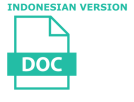Students’ Perception of The Use of YouTube as A Digital Platform in Vocabulary Mastery
Harits Masduqi(1*), Fitri Zakiyatul Azizah(2)
(1) Universitas Negeri Malang
(2) Universitas Negeri Malang
(*) Corresponding Author
Abstract
Keywords
Full Text:
PDFReferences
Albiladi W. S., Abdeen, F. H., & Lincoln, F. (2018). Learning English through movies: Adult English language learners' perceptions. Theory and Practice in Language Studies, 8(12), 1567-1574. https://doi.org/10.17507/tpls.0812.01
Aliyev, A., & Ismayilov, K. (2017). Improving English writing skills of non-native undergraduate learners with the help of movies supported by online technologies. Journal of Education in Black Sea Region, 2(2), 1-16. https://doi.org/10.31578/jebs.v2i2.38
Cadiz-Gabejan, A. M. (2021). Enhancing students' confidence in an English language classroom. International Journal of English Language Studies, 3(5), 16-25. https://doi.org/10.32996/ijels.2021.3.5.3
Cahyono, A. D. (2021). Students' perception toward the use of YouTube in learning vocabulary. Language-Edu, 10(1), 1-9. https://jim.unisma.ac.id/index.php/LANG/article/view/9658
Dzihnie, Z. N., & Gozali, A. (2023). Vocational school students’ perceptions of learning extensive listening through YouTube videos. English Franca: Academic Journal of English Language and Education, 7(1), 191-202. https://doi.org/10.29240/ef.v7i1.6936
Fatimah & Masduqi, H. (2021). Learning vocabulary through games: A critical review. EDUCAFL: Journal of Education of English as a Foreign Language 4 (2), 64-69. https://www.doi.org/10.21776/ub.educafl.2021.004.02.02
Hariyono, T. C. (2020). Teaching vocabulary to young learners using videos on YouTube in English courses. Language Research Society, 1(1), 41-46. https://doi.org/10.33021/lrs.v1i1.1038
Islamiah, N., & Yudha, A. (2021). Students' perception of using Youtube in learning English. Journal of English Teaching, Applied Linguistics and Literatures (JETALL), 4(2), 181-188. https://doi.org/10.20527/jetall.v4i2.8814
Kabooha, R. H. (2016). Using movies in EFL classrooms: A study conducted at the English Language Institute (ELI), King Abdul-Aziz University. English Language Teaching, 9(3), 248–267. https://doi.org/10.5539/elt.v9n3p248
Kabooha, R., & Elyas, T. (2018). The effects of YouTube in multimedia instruction for vocabulary learning: Perceptions of EFL students and teachers. English Language Teaching, 11(2), 72-81. https://doi.org/10.5539/elt.v11n2p72
Kelen, M. A. S. (2022). The Use of animation video to improve the eighth grader's vocabulary mastery at Yapenthom 1 Junior High School Mature in the academic year of 2021/2022. Edunipa Journal, 2(3), 53-63.
Liando, N., Sahetapy, R. J., & Maru, M. G. (2018). English major students' perceptions of watching English movies in developing listening and speaking skills. Advances in Social Sciences Research Journal, 5(6), 1-16. https://doi.org/10.14738/assrj.56.4627
Listiani, N. K. M., Suwastini, N. K. A., Dantes, G. R., Adnyani, N. L. P. S., & Jayantin, I. G. A. S. R. (2021). YouTube is a digital learning resource for teaching young bilingual learners. In 2nd International Conference on Technology and Educational Science (ICTES 2020) (pp. 156-162). Atlantis Press. https://doi.org/10.2991/assehr.k.210407.230
Masduqi, H., Fatimah, F., & Subiyanto, A. (2024). Why communicative approach culturally fails in Indonesia. Journal of Literature and Education, 2(2), 119-126. https://doi.org/10.69815/jle.v2i2.25
Masduqi, H. & Fatimah, F. (2022). Focusing on the EFL learners’ spoken language: An analysis of classroom discourse. KnE Social Sciences, 152-159. https://doi.org/10.18502/kss.v7i7.10659
Mokodompit, R. N., Samola, N. F., & Tuerah, J. C. (2021). Students' perception of using YouTube in vocabulary mastery. Journal of English Language and Literature Teaching, 5(2). https://doi.org/10.36412/jellt.v5i2.2456
Nelson-Smith, K. Q. (2008). Learning styles and student's perception of teachers' attitudes and its relation to truancy among African Americans students in secondary education. Louisiana State University and Agricultural & Mechanical College. https://repository.lsu.edu/gradschool_dissertations/3343/
Pamungkas, I. B. (2022). Maximizing English speech on YouTube videos to enrich students’ vocabulary. English Teaching Journal, 12(2), 62-65. https://doi.org/10.18592/let.v12i2.7485
Saputra, M. A. (2022). Student perceptions on the use of YouTube in increasing vocabulary. Jurnal Riset Rumpun Ilmu Pendidikan, 1(2), 329-340. https://doi.org/10.55606/jurripen.v1i2.1219
Sari, A., & Sugandi, B. (2015). Teaching English through English movies: Advantages and disadvantages. The Journal of English Literacy Education, 2(2), 10-15.
Sari, S. N., & Aminatun, D. (2021). Students' perception of the use of English movies to improve vocabulary mastery. Journal of English Language Teaching and Learning, 2(1), 16-22. https://doi.org/10.33365/jeltl.v2i1.757
Saraswati, S., Yaniafari, R. P., & El Khoiri, N. (2021). Students' perception toward the role of YouTube videos in improving their speaking skills. JoLLA: Journal of Language, Literature, and Arts, 1(12), 1765-1774. https://doi.org/10.17977/um064v1i122021p1765-1774
Slavin, R. E. (1995). Cooperative learning: Theory, research, and practice (2nd ed.). Boston: Allyn & Bacon.
Stimson, R., McCrea, R., & Western, J. (2011). The Brisbane-South East Queensland region, Australia: Subjective assessment of quality of urban life and changes over time. Investigating Quality of Urban Life: Theory, Methods, and Empirical Research, 185-207. https://link.springer.com/chapter/10.1007/978-94-007-1742-8_8
Suardi, S. (2021). Students' interest in learning English vocabulary for engineering by using YouTube. Jurnal Onoma: Pendidikan, Bahasa, dan Sastra, 7(1), 321-326. https://doi.org/10.30605/onoma.v7i1.1185
Tahmina, T. (2023). Students' perception of the use of YouTube in English language learning. Journal of Languages and Language Teaching, 11(1), 151–159. https://doi.org/10.33394/jollt.v11i1.6883
Article Metrics
Refbacks
- There are currently no refbacks.
Copyright (c) 2024 JLA

This work is licensed under a Creative Commons Attribution-ShareAlike 4.0 International License.







